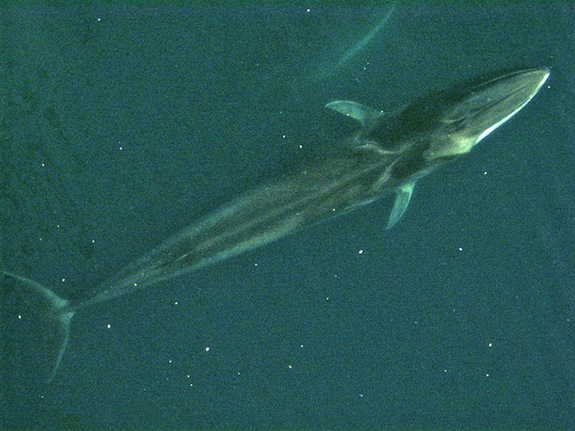What Will They Do With The Body of a Beached Whale in Queens?
Rescuers, locals and conservationists have been trying to figure out just what to with the body of a fin whale that died in Queens on Thursday

Image: NOAA
On Wednesday morning, a 60-foot fin whale washed up on the beach in Breezy Point, Queens. On Thursday afternoon, the whale died. Since then, rescuers, locals and conservationists have been trying to figure out just what to with the body.
It wasn’t a surprise that the whale died. According the The New York Times‘ CityRoom blog:
As evening fell, the whale, severely underweight even at about 60 tons, was alive, but its breathing was slowing, and it was not long for this world, rescuers said.
“Unfortunately, this animal is so emaciated, there’s nothing we can do,” said Kim Durham, rescue program director for the Riverhead Foundation on Long Island, the region’s official rescuer of stranded marine mammals.
Now, the dead whale’s body has a few potential fates. First, the body will be dragged up to the dunes about 100 feet away for an open-air necropsy. The researchers want to learn perhaps what killed the whale and how old it was when it washed up. Moving the body is no small feat: while no one has actually weighed the whale, it’s heavy. (The Times says in later coverage that based on its length “it should have weighed around 60 tons,” and the New York Daily News gives its weight as 25 tons.) No one really knows how they’re going to get the body up there. The next step is still a bit up in the air, says the Times:
After the necropsy – and, if an interested museum can be found, the removal and donation of the whale’s skeleton – whatever is left of the animal will be buried on the spot. The whale cannot be towed back out to sea, Mr. Avrin said. “It’s a hazard to navigation,” he said. “It will just end up on somebody else’s dunes.”
As the wind whipped up on Thursday, the seawater around the animal’s drooping tail grew red with blood. Seagulls stood their distance, looking unsure what to do as the gathering of humans discussed plans by the animal’s head.
Finback whales are endangered, with about 174 in the Hawaiian population, 2,541 on the West Coast and 5,700 in Alaska. The IUCN writes:
The analysis in this assessment estimates that the global population has declined by more than 70% over the last three generations (1929-2007), although in the absence of current substantial catches it is probably increasing. Most of the global decline over the last three generations is attributable to the major decline in the Southern Hemisphere. The North Atlantic subpopulation may have increased, while the trend in the North Pacific subpopulation is uncertain.
More from Smithsonian.com:
/https://tf-cmsv2-smithsonianmag-media.s3.amazonaws.com/accounts/headshot/Rose-Eveleth-240.jpg)
/https://tf-cmsv2-smithsonianmag-media.s3.amazonaws.com/accounts/headshot/Rose-Eveleth-240.jpg)